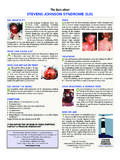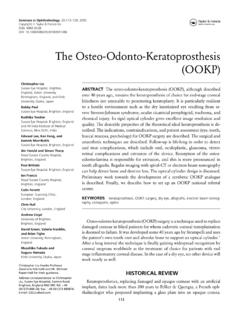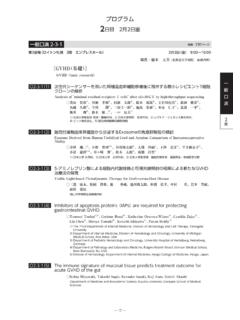Transcription of 1. Stevens-Johnson Syndrome and Toxic Epidermal …
1 Treatment of Severe Drug Reactions1. Stevens-Johnson Syndrome and Toxic Epidermal NecrolysisDefinitionSJS and TEN are variants of the same process, presenting as severe mucosal erosionswith widespread erythematous, cutaneous macules or atypical targets. The cutaneouslesions often become confluent and show a positive Nikolsky sign and epidermaldetachment. In SJS, Epidermal detachment involves less than 10% of the total body skinarea; transitional SJS-TEN is defined by an Epidermal detachment between 10 and 30%;TEN is defined by a detachment greater than 30%. Full-thickness Epidermal necrosis isobserved on pathological examination. This clinical definition separates SJS-TEN fromerythema multiforme on case registries and observational studies, the incidence of TEN is estimated tobe cases per million inhabitants per year. The incidence of SJS is probably of thesame order (1-3 cases per million inhabitants per year).
2 [1,2,3]Etiology/Risk FactorsSJS-TEN is essentially drug-induced. Graft versus host disease is another well-established cause, independent of drugs. A few cases are related to infections(Mycoplasmapneumoniae), and a few other cases remain unexplained. The mostextensive study of medication use and SJS-TEN mainly pointed to antibacterialsulfonamides, anticonvulsant agents, some nonsteroidal anti-inflammatory drugs andallopurinol.[4] HIV infection dramatically increases the risk. A predisposing effect ofautoimmune disorders, such as systemic lupus, and an HLA-linked, genetic susceptibilityhave been also is an acute, self-limited disease, with high morbidity, that is potentially life-threatening. Mortality rates are 5% with SJS, 30-35% with TEN and 10-15% withtransitional forms. Epidermal detachment may be extensive, to the entire skin surface. Asin severe burns, fluid losses are massive, producing electrolyte imbalance.
3 Super-infection, thermoregulation impairment, excessive energy expenditure, alteration ofimmunologic functions and hematologic abnormalities are usual systemic membrane involvement (oropharynx, eyes, genitalia and anus) require attentivenursing care. The tracheobronchial epithelium, and less often gastrointestinal epitheliumcan be involved and cause high morbidity. Age, percentage of denuded skin, neutropenia,serum urea nitrogen level, and visceral involvement are prognostic factors. There aredifferent scoring systems for vital prognosis estimation, SAPS and SAPS 11 (SimplifiedAcute Physiology Score), which are not specific. A specific score (SCORTEN) has beenrecently elaborated and validated.[5] After healing, altered pigmentation and corneallesions are the main long-term managementThe management of patients must be prompt; early diagnosis with the early recognitionand withdrawal of all potential causitive drugs is essential to a favorable and mortality increase if the culprit drug is withdrawn late.
4 We observed thatdeath rates were lower when causative drugs with short elimination half-lives werewithdrawn no later than the day when blisters or erosions first occurred. No differencewas seen for drugs with long half-lives.[6]Second, intravenous fluid replacement must be initiated using macromolecules or , the patient must be transferred to an intensive care unit or a burn center. Promptreferral reduces risk of infection, mortality rate and length of hospitalization.[7,8,9]Symptomatic treatmentGeneral principles. The main types of symptomatic treatment are the same as for burns,and the experience of burn units is helpful for the treatment of TEN: environmentaltemperature control, careful and aseptic handling, sterile field creation, avoidance of anyadhesive material, maintenance of venous peripheral access distant from affected areas(no central line when possible), initiation of oral nutrition by nasogastric tube,anticoagulation, prevention of stress ulcer, and medication administration for pain andanxiety control are all , TEN and burned patients are not identical: burns happen in a very short timeperiod (a few seconds) and do not spread thereafter; the TEN-SJS progress occurs duringseveral days, including after hospital admittance.
5 Cutaneous necrosis is more variable andoften deeper in burns than in differences induce a some important management specificities. Subcutaneousedema is a very uncommon feature of TEN, in contrast with burns, probably because ofmilder injury to blood vessels. Therefore the fluid requirements of TEN patients arehabitually two-thirds to three-fourths of those of patients with burns covering the samearea. Since the lesions are restricted to the epidermis and usually spare the hair follicles,the regrowth of epidermis is quick in patients with SJS-TEN. This supports a differentapproach of topical management. Pulmonary care includes aerosols, bronchial aspiration andphysical therapy. If the trachea and bronchi are involved, intubation and mechanicalventilation are nearly always necessary. Early and continuous enteral nutrition decreasesthe risk of stress ulcer, reduces bacterial translocation and enterogenic infection, andallows earlier discontinuation of venous lines.
6 [10] Phosphorus levels must be measuredand corrected, if necessary. Profound hypophosphoremia is frequent and may contributeto altered regulation of glycemia and to muscular dysfunction. Most authors do not useprophylactic antibiotics. Catheters are changed and cultured regularly. Bacterial samplingof the skin lesions is performed the first day and every 48 hours. Indications for antibiotictreatment include an increased number of bacteria cultured from the skin with selectionof a single strain, a sudden drop in temperature, and deterioration in the patient'scondition. S. aureus is the main bacteria present during the first days, and gram negativestrains appear temperature is raised to 30 to 32 degrees,C. This reduces caloric lossesthrough the skin and the resultant shivering and stress. Heat loss can also be limited byraising the temperature of antiseptic baths to 35v' to 38(C and by using heat shields,infrared lamps, and air-fluidized drugs are needed.)
7 Thromboembolism is an important cause of morbidity and death;effective anticoagulation with heparin is recommended for the duration ofhospitalization.[11] Although this results in increased bleeding from the skin, it is usuallylimited in amount and does not require additional transfusion. Antacids reduce theincidence of gastric bleeding. Emotional and psychiatric support must not be such as diazepam and morphinic analgesics can be used liberally if therespiratory status is administered when hyperglycemia leads to overt glycosuria or to reviews have been published about intravenous and oral supplementation on burncare: oxandrolone and human growth factor are effective for decreasing hypercatabolismand net nitrogenous loss;[12,13] ornithine alpha-ketoglutarate supplementation of enteralfeeding is effective to reduce wound healing time;[14] high dose ascorbic acid (66 mg/kgper hour) given during the first 24 hours reduces fluid volume requirements.
8 [15] Theusefulness of these treatments is not established in TEN/SJS and is probably lower thanfor burns because of a shorter duration of skin management. No consensus exists about topical care. Possible approaches maybe conservative or more aggressive (large operative debridement). In our opinion,conservative care is better than any surgical method. Even though we did not perform anystudy, it has been our experience that the areas with a positive Nikolski, potentiallydetached by any trauma healed much more rapidly where the epidermis stayed on sitethan on similar areas where the epidermis had been detached. We leave in place theinvolved "detachable" epidermis and use dressings only to protect it. Topical antiseptics( silver nitrate or chlorhexidine) are used to paint, bathe, or dress the may be gauzes with petrolatum, silver nitrate, polyvidoneiodine, or authors use biologic skin covers after Epidermal stripping (cadaveric allografts,cultured human allogeneic or autologous Epidermal sheets).
9 New dressings are beinginvestigated: Apligraft(r), Biobrane(r), TransCyte(r) (human newborn fibroblasts culturedon the nylon mesh of Biobranee). In burns, topical recombinant bovine basic fibroblastgrowth factor allowed faster granulation tissue formation and Epidermal regeneration thanplacebo.[16]Prevention of ocular sequelae requires daily examination by an ophtalmologist. Eyedrops, physiologic saline, or antibiotics if needed, are instilled every 2 hours anddeveloping synechiae are disrupted by a blunt instrument. It is suggested that wearinggas-permeable scleral contact lenses reduces photophobia and discomfort; these lensesimprove visual acuity and heal corneal epithelial defects in half of patients.[17]Oral and nasal crusts are removed, and the mouth is sprayed with antiseptics severaltimes a treatmentCorticosteroids. Corticosteroid use is highly debated. These drugs are a mainstay insome units, bur other investigators consider systemic corticosteroids to provokeprolonged wound healing, increased risk of infection, masking of early signs of sepsis,severe gastrointestinal bleeding and increased mortality.
10 A review of the literature showsonly patients series and no randomized clinical trials. Several articles reportedcorticosteroids benefit: Tegelberg used 400 or 200 mg prednisone/day, graduallydiminished over a 4 to 6 week period, and observed a single death among eightpatients[18]. Others series claimed also excellent results but the diagnosis of SJS-TEN wasdebatable for most of the cases.[19,20,21,22,23] In two retrospective studies, no difference inmortality rates or infectious complications was noted in patients who received steroidsbefore or after referral.[24,25]By contrast, other studies claimed that corticosteroid use was detrimental. Thirty patientswith SJS or TEN were included in an uncontrolled prospective study. The first 15patients received corticosteroids and the mortality rate was 66%. Therefore, the next 15patients were treated without corticoids and the mortality rate was 33%.






